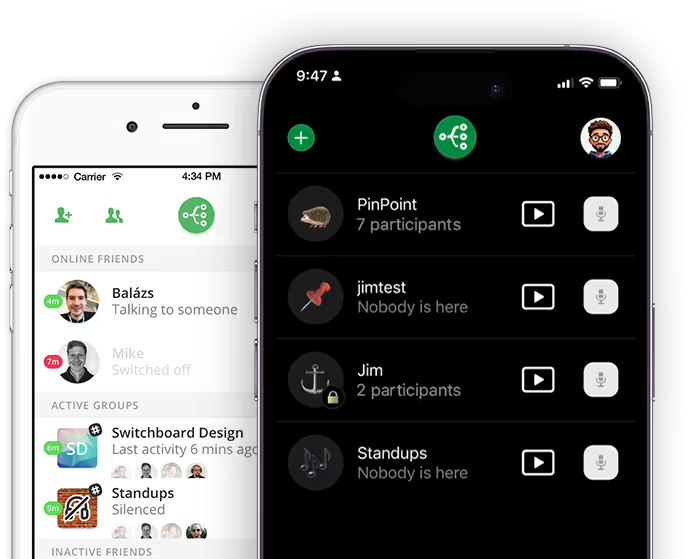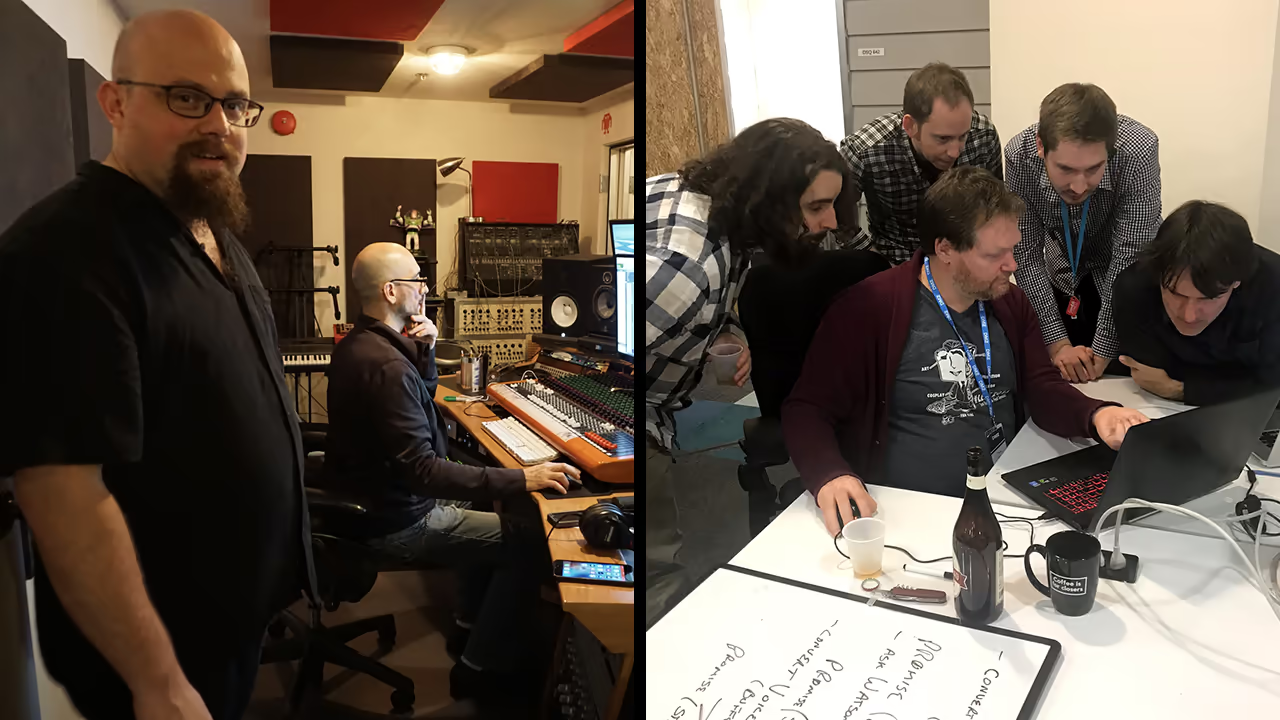Why we built Switchboard
I am not a software engineer. But I count myself lucky to work with them on a daily basis. Having started my career as a mechanical engineer in the mid 2000s and then transitioned through roles in management, finance, and, for the last decade, startups, I’ve come to respect software engineers as, on average, the smartest and most ethical people I know. It wasn’t my original plan to start a dev tools company, but I’m glad I ended up here.
It’s become clear to me that to build out our vision for the future of the social internet — including the many new formats of live collaboration and entertainment that are now in development — it’s not going to come from any one company. It’s going to come from a collection of creative people across multiple companies working towards independent but similar goals. And my hope is that, in Switchboard, we have a platform to bring together a majority of developers and product teams who share similar goals: especially those who want to make the social internet a better place.
That will encompass a lot of things. Products that surface the right moments to reconnect with old friends. Products that bring you together with your closest friends more often — to hang out in person or online. Products that make it easy to meet new human friends or even to fill in some gaps with AI companions — to a point of course. There are some pretty cringe-worthy products out there and hopefully we can help mitigate that by making it easier for well-meaning creatives to build better alternatives. Alternatives where people are interacting with one another in real time rather than doomscrolling alone. Talking over texting.
We also want to enable new social experiences on consumer electronics devices including TVs, speakers, headphones, vehicle infotainment systems, and professional settings such as offices and events spaces. The products built into these systems might aspect towards entertainment or making work more efficient and enjoyable. They might even start to blur the lines between work and play as AI takes over the mundane stuff. In any case, communication is the foundation of all of it, and voice in particular.
Text isn’t going away. But voice is becoming more important, and thankfully so. Talking, as opposed to texting, will start to pull our social fabric in the right direction as conversations start to feel more human again. In person and voice communication are the backbone of a healthy society. And voice technology is the backbone of Switchboard.

We didn’t start here
We didn’t start as a developer tools company. We built a voice-first app that was full of real time audio features and it turned out to be really hard to build. You can learn more about that here, but suffice it to say that we learned a lot — both about consumer behavior and real time audio tech — and came to the realization that there was a huge opportunity. Not just to make developers’ lives easier by providing a technology stack that saves them from the headaches we had ourselves. But to bring likeminded developers together towards a common goal.
To that end, the Switchboard Network is a part of our vision. It’s early days and we don’t know exactly how we'll pull this off, but the future of social will look a whole lot better if we do. So what is the Switchboard Network?
As developers and product teams start to incorporate Switchboard into their real time voice products, an opportunity emerges. We want to provide a feature that would allow a subset of Switchboard-powered products to opt into cross-application voice communication. Something like a telephone network — where you have different carriers, different phone manufacturers, and different phone numbers with different purposes — but a common network. Rather than phone numbers, we can employ AI to help mediate cross-app communication and use it to surface the right moments to bring people together, alongside activities they can enjoy together in real time: music, TV, tools that let you explore and create together, etc. That’s what we’re really aiming towards: a real-time social internet facilitated by the Switchboard Network.
We got started building this vision with our first app, the Switchboard App. And we’re still exploring the B2C side of this equation with Kosmi. But what’s become clear is that this vision doesn’t exist within a single app. It exists in part inside Discord, Slack, X, WhatsApp, TikTok, YouTube, a multitude of other messaging apps, social apps, games and content streaming apps, and part inside whatever comes to replace “apps” — such as the AI agents that will live inside your devices and operating systems and connect you across various accounts, services, and social networks.
The technologies we’ve prioritized inside the Switchboard SDK are the technologies that help developers build this future. And, we hope, a subset of developers using Switchboard will opt into our vision: bringing product teams and user bases together into a unified vision of a better social internet: a decentralized voice communication network that helps people connect with who they want, when they want, from wherever they want, alongside interactive live activities that cut across walled gardens.

Some practical considerations
Why is Switchboard even needed in an era of AI-generated products? First, we don’t think the best products will be 100% vibe-coded, at least not any time soon. We think the best products will be assisted by AI generation on top of thoughtfully designed tools and frameworks that are modular, well architected, and easy to debug and maintain. We think the best products will use humans to orchestrate AI in a way that is uniquely human, aligned with the goals of the human teams designing and building those products.
We’ve designed Switchboard to make this orchestration easier, allowing the AI to assemble products with building blocks — called Nodes. Not only can AI help to write new nodes if necessary, but the way the blocks connect together remains consistent and auditable. This ensures Switchboard-powered products remain robust, scalable, and flexible. Moreover, they will be built on a framework that will allow for the eventual interoperability with the Switchboard Network.
We prioritize adding new nodes to our library in a few ways. We started with the nodes that power the use cases we’ve been passionate about for so long. For example, our team is full of musicians and we’ve always loved the idea of being able to listen to music together with a live voice channel (for fitness, remote work, and other use cases) — so you will find nodes related to streaming music, voice over IP, mixing, and auto-ducking (using voice detection to lower the music when someone speaks). You will also find nodes related to real time language translation and a few other things where we started by scratching our own itch — enabling new use cases that we hadn’t yet seen elsewhere.
We dogfood Switchboard to build these use cases out as example apps that we then open source. And we will keep doing so because there are so many cool use cases that haven't been built yet. Switchboard makes them easy to build, so we intend to keep open sourcing not just ideas — but fully working prototypes that others can polish, remix, and distribute.
We’re usually not alone in the use cases we’re passionate about. Soon after releasing new example apps and blog posts that accompany them, we’ve found ourselves talking to likeminded teams. We use this feedback loop to help us prioritize our backlog — including the long list of nodes we intend to add to our library to expand the number of possible use cases even further. We do our best to balance what our customers are asking for right now vs. where we see big forward-looking opportunities.
We’ve also provided a framework to “Bring Your Own Node” so that any developer can add any node that we haven’t yet gotten around to, or to merely extend their own technology (such as a voice or audio ML model or algorithm) with the additional functionality Switchboard provides.

So what problems are we addressing?
We’re a team of engineers who are passionate about solving problems and we've encountered a huge list of development challenges and platform limitations over the last 10 years or so of working together in the domain of real time voice and audio systems.
On the one hand, many of these relate to software development. And the vast majority of our team are software engineers. So we’re motivated to make developers’ lives easier. Most product development teams don’t want to spend time stitching together voice activity detection, ASR, noise suppression, speech synthesis, WebRTC, and handling other low low level audio problems or OS issues. And when these teams try to use AI to help, they often wind up with spaghetti pipelines no one can debug later. That’s a problem we can help solve – and we are solving, with Switchboard.
But in addition to that, there’s a bigger vision we share, and that’s what got us started in the first place. The internet is filled with ways to communicate. Every app wants to be the one place you spend time, and yet none of them get it really right. We want to help connect people – not just inside one app, but across them. We want to connect not just users, but developers and entrepreneurs with a similar vision.
We see a very promising future for voice communication and real-time interactivity. We want Switchboard to be the backbone of that.
If that resonates, we hope you’ll give it a try or reach out to learn more.
If you don’t know what you’re building yet or are unsure of whether you could get your company onboard, but would love to stay informed – feel free to share your email and we’ll keep you apprised of product updates, company news, and the like.
Thanks for your interest
— Jim
